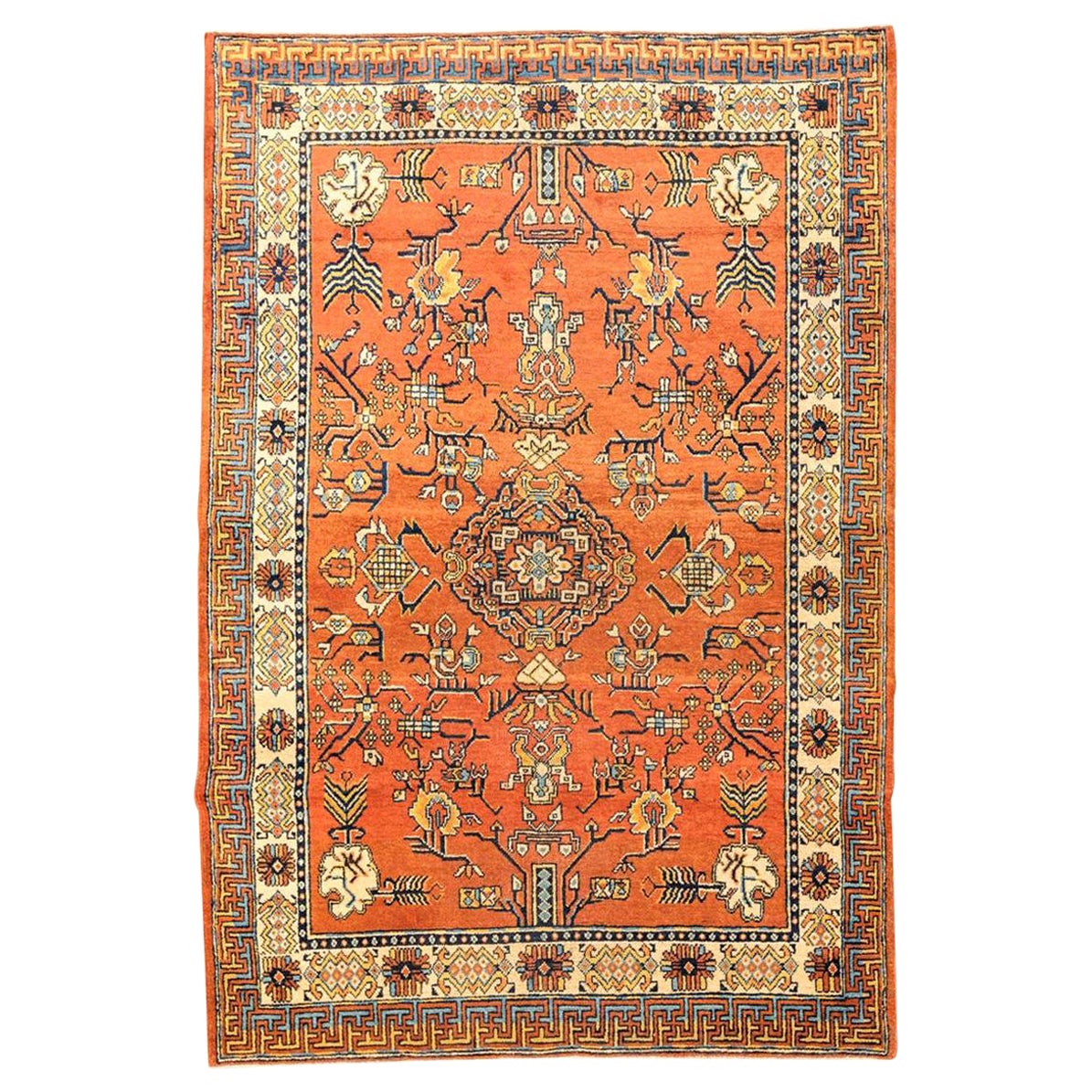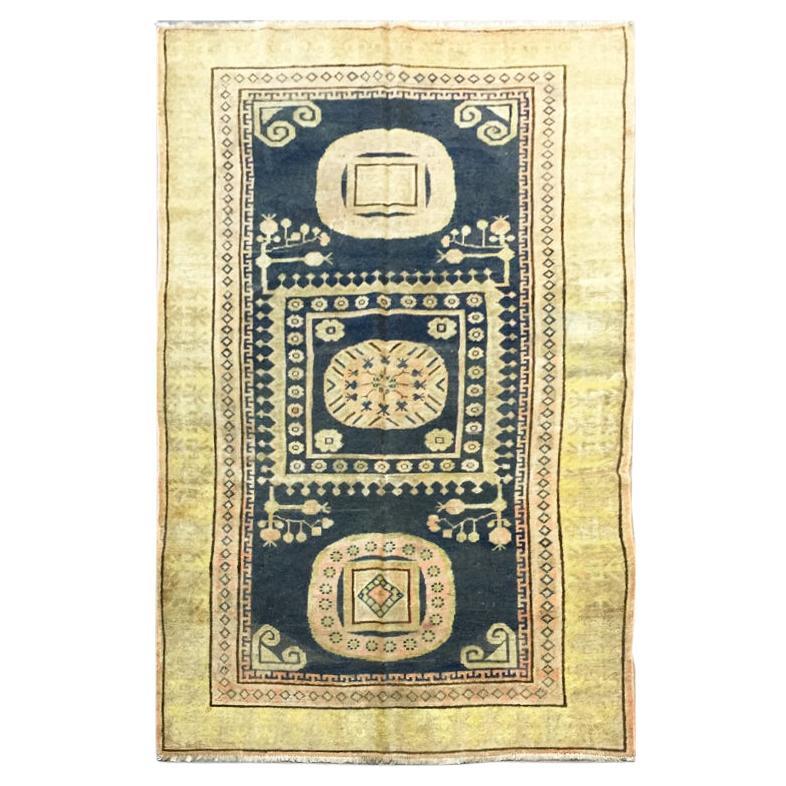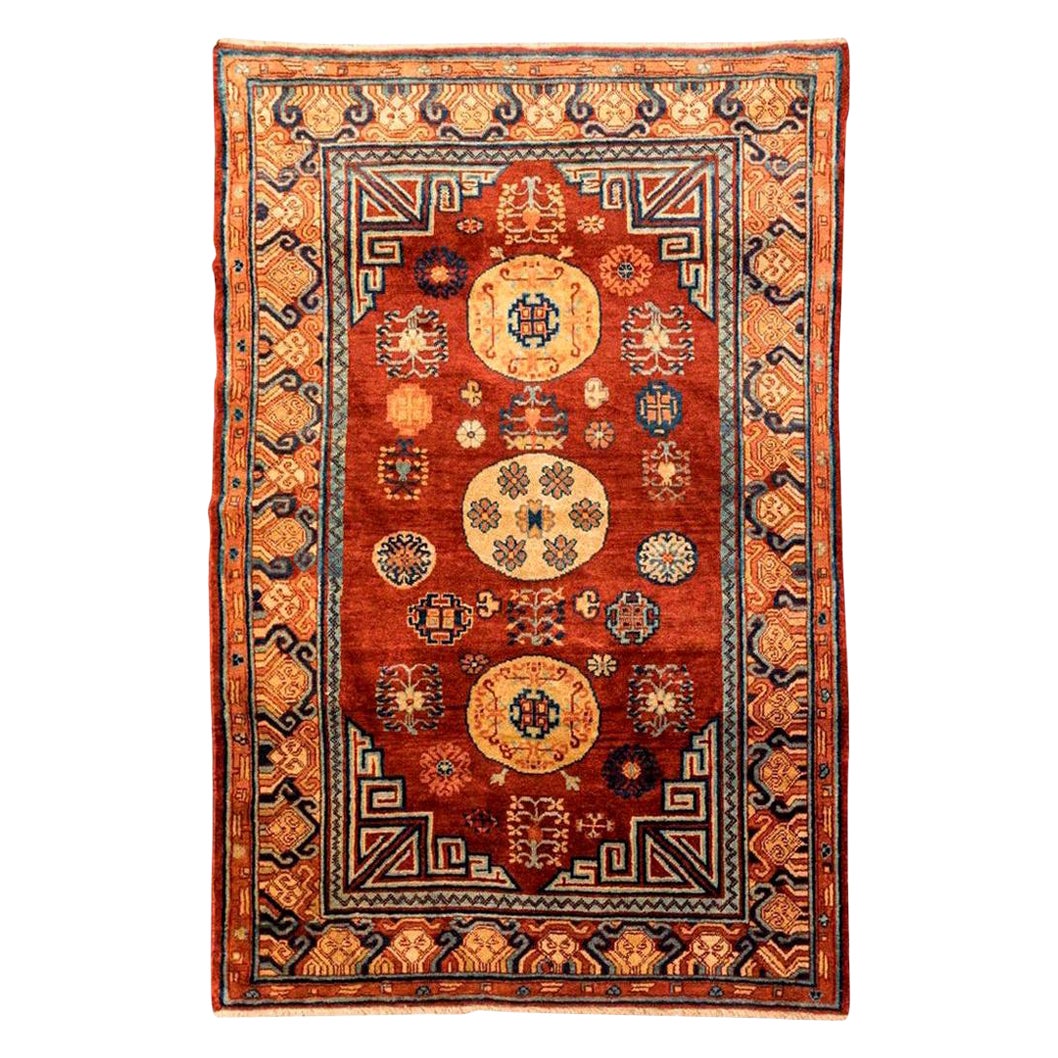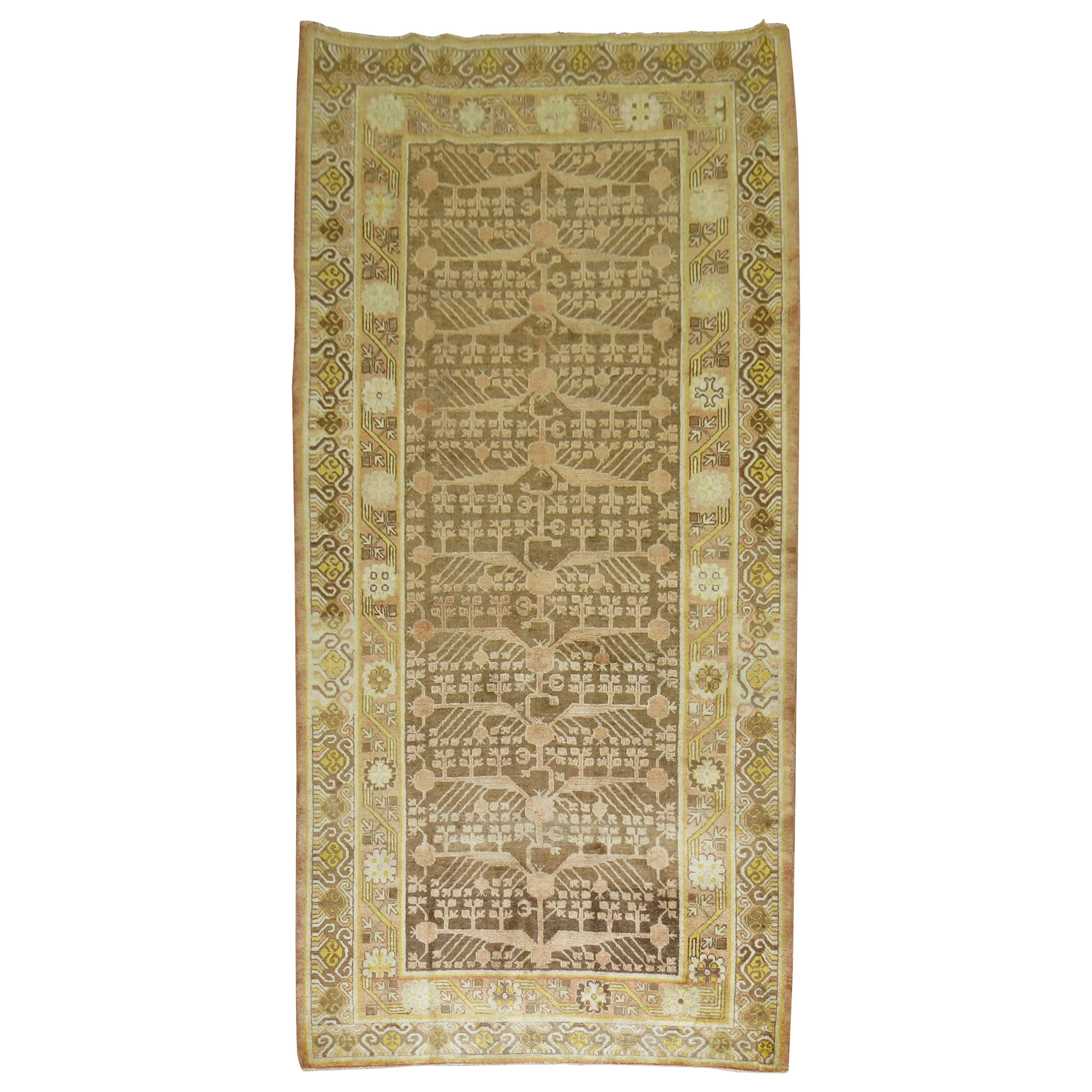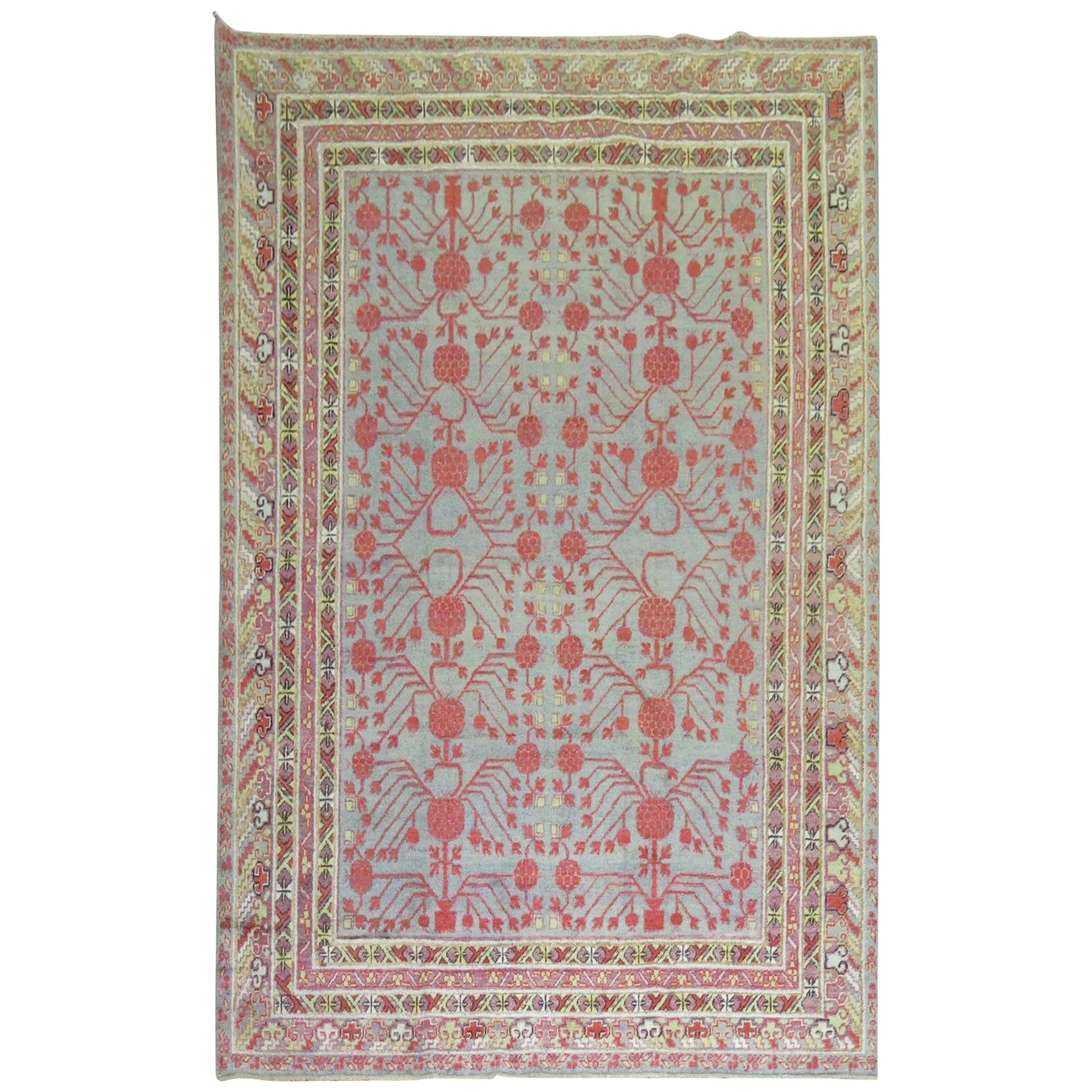Items Similar to 20th Century Red and Brown Pomegranate Kothan Handmade Rug, circa 1900
Want more images or videos?
Request additional images or videos from the seller
1 of 17
20th Century Red and Brown Pomegranate Kothan Handmade Rug, circa 1900
About the Item
This carpet has the characteristic pomegranate motif typical of the production of the carpets of the Khotan and Yarkand oasis in Chinese Turchestan, they are centuries-old post stations on the southern arm of the Silk Road (today Sinkiang).
The rugs produced in these places are an expression of the meeting of different civilizations, which have been able to merge elements of Far Eastern art culture in these artefacts with textile knowledge and the very ancient language of the carpets of the nomads of Central Asia.
The motif of the decoration contains in its simplicity a complex symbolism. The tree of life that emerges from the two symmetrically arranged pots and the pomegranate is a universal symbol of fertility.
- Dimensions:Width: 53.15 in (135 cm)Length: 106.3 in (270 cm)
- Materials and Techniques:Wool,Hand-Knotted
- Place of Origin:
- Period:
- Date of Manufacture:circa 1900
- Condition:Wear consistent with age and use.
- Seller Location:Firenze, IT
- Reference Number:
About the Seller
5.0
Vetted Seller
These experienced sellers undergo a comprehensive evaluation by our team of in-house experts.
Established in 1930
1stDibs seller since 2018
29 sales on 1stDibs
Typical response time: 3 hours
- ShippingRetrieving quote...Ships From: Firenze, Italy
- Return PolicyA return for this item may be initiated within 14 days of delivery.
More From This SellerView All
- 20th Century Red Blu Geometric MultiBorders Turkmenistan Rug, ca 1910Located in Firenze, ITChuval is the bag used by Turkmen nomads to carry supplies and everyday objects, also used as wall decoration inside the tents. Fierce, tending to sedentary, the Yomut is one of the ...Category
Early 20th Century Turkmen Tribal Central Asian Rugs
MaterialsWool
- 20th Century Multicolor Deco Runner Ozbek Rug, € 1650Located in Firenze, ITVery particular drawing of this carpet comes from Afghanistan. The country has a long tradition of rug tunes. With a view to re-evaluating the artisan work of these populations and t...Category
21st Century and Contemporary Afghan Art Deco Central Asian Rugs
MaterialsWool
- 20th Century Pink and Blue Floreal with Medallion Samarkand Rug, Ca 1920Located in Firenze, ITThe term Samarkand identifies those carpets produced by nomadic artisans at the centers of Khotan, Yarkand, Kashgar and the bazaar of Samarkand is the place of collection and trade. ...Category
Early 20th Century Uzbek Central Asian Rugs
MaterialsWool
- 20th Century White and Brown Roman Coptic Design North Africa Rug, circa 1900sLocated in Firenze, ITCarpet in natural knotted wool with symmetrical knot, handicraft production of North Africa. The design of this rug reproduces a late Roman (Coptic) fabric. The drawing refers to ve...Category
Early 20th Century North African Classical Roman Moroccan and North Afri...
MaterialsWool
- 21st Century Yellow and Brown Tibetan Tiger Mantle Rug, circa 2019Located in Firenze, ITModern but at the same time Classic carpet hand knotted in Nepal with the Tibetan knot technique. The colors and decoration are a clear reference to the tiger's mantel (fireplace), w...Category
21st Century and Contemporary Nepalese Central Asian Rugs
MaterialsWool
- 20th Century Blu White Multicolored Tibetan Yuran Rug Hand Knotted Wool, 1960sLocated in Firenze, ITTibetan Yuran rug, first half of the 20th century characterized by a multicolored field. Fleece in wool, warp and weft in cotton. Thickness: 10 mm. Hand knotted in Tibet circa 1960 ...Category
Mid-20th Century Tibetan Tibetan Central Asian Rugs
MaterialsWool
You May Also Like
- 20th Century Handmade Wool Samarkand Rug, Kothan Design, circa 1900Located in MADRID, ESSamarkand rug, Kothan design with influences of Chinese rugs and of de ancient silk road, circa 1900. - We highlight the quality of the conservation of colors. - Colors in caramel to...Category
Early 20th Century Central Asian Khotan Central Asian Rugs
MaterialsWool
- 20th Century Samarkand Wool Rug Kothan Design circa 1900.Located in MADRID, ESWool rug of the ancient silk road. - Kothan design with influences of the Chinese rugs in regard to the Ionic capitals that appear in the work of the valance and Buddhist influence w...Category
Antique Early 1900s Turkestan Khotan Central Asian Rugs
MaterialsWool
- 20th Century Samarkand Wool Caramel Color Rug Kothan Design circa 1900.Located in MADRID, ESWool rug of the ancient silk road. - Kothan design with influences of the Chinese rugs in regard to the Ionic capitals that appear in the work of the valance and Buddhist influence w...Category
Antique Early 1900s Turkestan Khotan Central Asian Rugs
MaterialsWool
- Wool 20th Century Gallery Size Brown Yellow Khotan Pomegranate Design RugLocated in New York, NYAuthentic early 20th century Khotan rug with repetitive pomegranate motif in predominant tones in brown, salmon and mustard yellow. Measures: 5'7" x 11' Khotan, an ancient Budd...Category
Vintage 1910s East Turkestani Chinoiserie Chinese and East Asian Rugs
MaterialsWool
- Early 20th Century Handmade East Turkestan Pomegranate Khotan RunnerLocated in New York, NYAn antique East Turkestan Khotan rug in runner format with a pomegranate design handmade during the mid-20th century. Measures: 2' 2" x 7' 6" Central Asian Rugs & Carpets: Central Asia is a vast area stretching from Northeastern Persia to western China, and from northern Afghanistan to the southern edge of Russia. The carpets can be usefully divided into three groups: the nomadic Turkmen rugs of Turkmenistan, northern Afghanistan, and northeastern Persia; the non-Turkmen tribal pieces from Kazakhstan, Uzbekistan, and Kirghizstan; and the urban creations of Khotan, Yarkand, and Kashgar, oasis cities of Western China (Xinjiang Province). Commercially, the most important group is from Khotan, the easternmost of the Chinese Turkestan cities. The craft of rug weaving is primarily in the hands of Muslim Uighurs. Khotan carpets mix purely Central Asian design themes with Chinese elements. Native Khotan devices include pomegranate trees, upright flowers, round medallions, and yellow or red grounds. Chinese motives include triangular fretwork corners, swastika fretwork, and Yun-Tsao Tou (clouds and rain) diagonally striped polychrome borders. Cotton foundations, asymmetrical (Persian) knots, and medium weaves are standard. Some vintage Khotan are in horizontal, pictorial layouts with multiple various vases and plants. Saphs (multiple prayer niche panel carpets) are also a Khotan specialty. Others employ stepped and layered lozenge medallions, singly or in pairs. Still others, almost all antique, feature a stylized version of the allover Persian Herati design. Many of the oldest pieces employ brown wool wefts. Antique and vintage Khotans are almost always in the k’ang (double square) layout, conforming to the local household plans. Only relatively recently has the 6’ by 12’ or 7’ by 16’ format been replaced by the 9’ by 12’ size. As a result, an antique room size Khotan carpet is very uncommon. Reds are cinnamon, tomato and rust, never wine reds, crimson, or scarlet. Yarkand, farther west on the old Silk Road specializes in multi-medallion long carpets while Kashgar, farthest west and most under Persian influence, has traditionally knotted allover pattern pieces with finer weaves, often with silk piles, and enriched with medal thread, on cotton foundations. Extant Kashgars go back to the 17th century, but the carpet craft in Chinese Turkestan must be much older as fragments have been recovered from local tombs of the early C.E. period. Kashgars are the rarest of all East Turkestan rugs. Most available vintage East Turkestan carpets are interwar Khotans, many with pleasingly soft decorative palettes. The non-Turkmen nomads include the Kazakh, Kirghiz, Uzbek, and Karakalpak groups. Like the Turkmen, they were once all seasonally migratory, dwelling in round felt tents (yurts), but have been settled, at least partially, in the villages, and have taken up crafts and agriculture instead of sheep herding. As a result, carpet production has transitioned from domestic tent use to commercial sale, but the roots of long traditions are still evident. The Uzbeks weave...Category
Early 20th Century East Turkestani Modern Central Asian Rugs
MaterialsWool
- Wool Early 20th Century Khotan Gray Field Red Pomegranate Full Pile RugLocated in New York, NYA full pile excellent condition early 20th century Khotan rug. Gray ground, red accent pomegranates throughout with a lavender multi band border, circa 1920, measures: 5'11" x 9'.Category
Early 20th Century East Turkestani Chinese Chippendale Central Asian Rugs
MaterialsWool
Recently Viewed
View AllMore Ways To Browse
Antique Handmade Rug
Antique Handmade Rugs
Handmade Antique Rugs
Pomegranate Furniture
Pomegranate Rug
Pomegranate Carpet
Silk Road
The Silk Road
Rug With Pomegranates
Brown Chinese Pot
Red Pot Chinese
Century Furniture Silk Road
Chinese Old Silk
Antique Artefacts
Oasis Bar
Antique Nomad
Far Eastern Antique
Tree Of Life Silk
